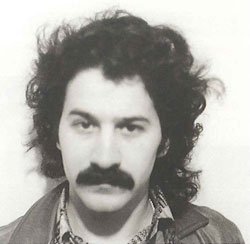António Palolo
António Palolo Évora ¶ 1946-2000 ¶ Lisboa
 |
|
| Créditos fotográficos / Photographic credits: DR/ Cortesia Galeria III |
Although an autodidact, he revealed from early on a desire to take on an experimentalist stance towards the visual arts. He would form a group with other young artists in such pursuit, such as Álvaro Lapa, Joaquim Bravo and António Charrua. ¶ His work throughout the 60s is basically a result of a constant blending and questioning of the dominant aesthetics of the international art scene, which drifted between informalism, formal abstractionism and pop art. His pictorial exercises, in which pure colour reach a high level of seduction, are able to organize a very peculiar, even original opticality, within the framework of Portuguese painting. Moreover, it is the definition of his contrasting colour areas that will dictate, during the second half of the 60s, his progressive rejection of his own early figurativism, tinted by a certain pop flavour. ¶ During the 70s, Palolo's chromatic explosion allies itself to a formal will, which begs for precise composition planning, a reconciliation between smooth colours and geometrical figures, and in which brush lines disappear entirely. This is an experience that seems to mix two apparently antagonist tendencies, pop and minimal art. ¶ When Palolo participates in the 1983 Depois do Modernismo (After Modernism) exhibition, he is already showing some concern towards the expressive values of pictorialism, somehow in the steps of a certain "Transavantgarde", revealing once again the meaningfulness of figuration in a pertinent dialogue with a new colour scheme and more expressionist, almost gesture-like techniques. In the 90s, Palolo squared off two distinct moments of his career, opening up the necessary conditions for the harmonization of composition with his bands of pure colour with the expressive, gesture exercises of his latest phase. ¶ Between the 70s and the 80s, incorporated in the time's transdisciplinary tendencies, António Palolo created a few installations and shot experimental movies, developing a formal approach in which the cinematics of image were crucial, with the expected repercussions on his pictorial work.
View the embedded image gallery online at:
http://cvc.instituto-camoes.pt/biografias-en/antonio-palolo-12321.html#sigFreeId75545fab1f
http://cvc.instituto-camoes.pt/biografias-en/antonio-palolo-12321.html#sigFreeId75545fab1f


